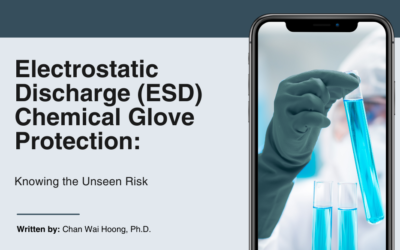When you are looking for gloves to handle chemicals, we guess you are not just merely looking for gloves. You are looking for protection, reliability, and most importantly, safety.
What criteria would you look at? Would you look at the packaging design? Glove’s appearance? Thickness? Grip? Or the glove’s materials?
When it comes to protective gloves for handling chemicals, since it is a PPE, there is a lot of considerations, and hence you will find much unfamiliar information being presented in the gloves packaging or on the gloves themselves.
That information makes the gloves look professional and reliable, but unfortunately, the majority do not really understand what that information is all about.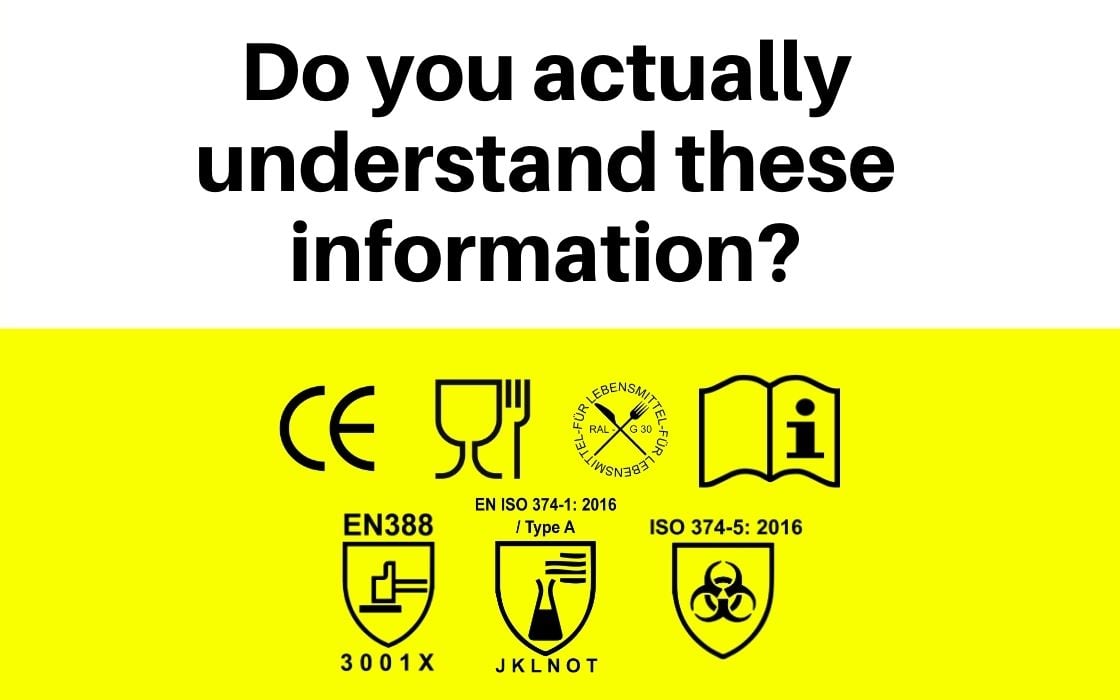
As a gloves manufacturer, since we are the ones who produce the gloves and send our products for testing and get certified, we think that we are in a position to communicate that complicated information in a simplified manner.
In our previous articles, we have been explaining what is CE, what is EN388 is all about as well as what is the meaning of the glass and fork, knife and fork pictograms.
No matter whether you are the purchasing manager, safety officer, company owner, or even end-user that comes across to this blog today, we hope that our info center will help you in gaining more knowledge about gloves products while you are researching for the right gloves.
So, back to the question:
If you are looking for gloves to protect your skin from direct contact with chemicals, how do you know which gloves is good in chemical resistance and how would you make your decision?
Look at the standard.
Well, a piece of glove might not have a sophisticated appearance, but the tests that it undergoes are certainly complex and professional. This is to make sure that gloves that have to undergo standardized certification can provide necessary protection against hazardous chemicals to the users.
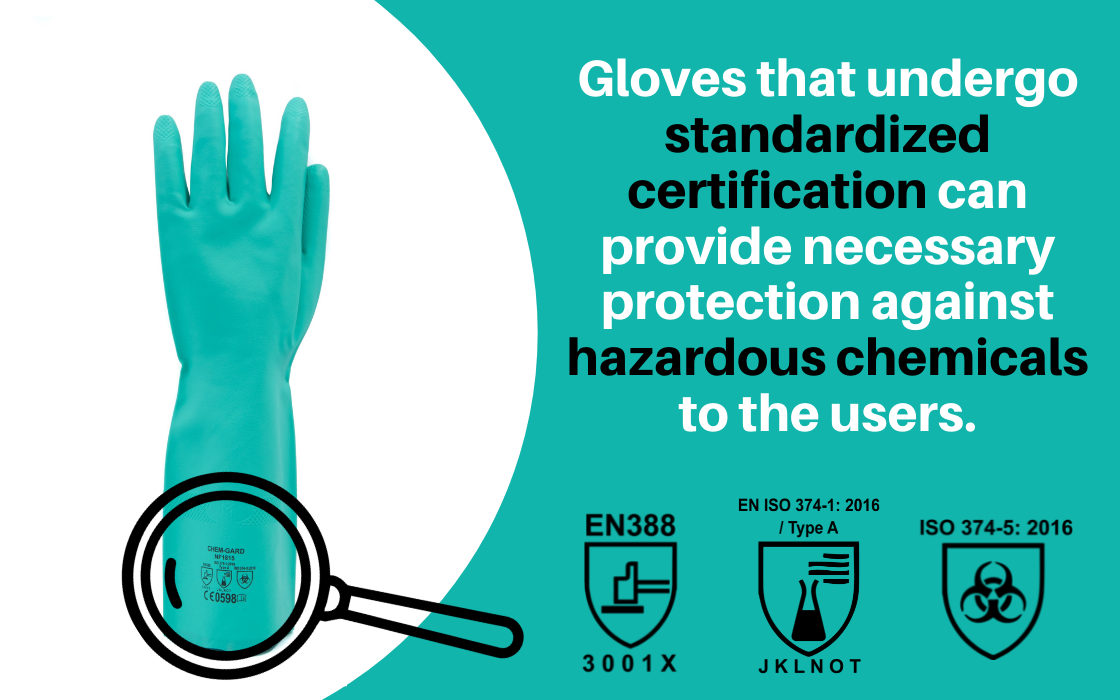
The standard is not only meant for product comparison, but it also provides sense of security to the users.
So, what kind of tests can a piece of glove undergo in order to test their ability to withstand against dangerous chemicals?
The answer can be found in EN ISO 374-1:2016 standard.
In this blog post, we will explain 3 major tests for chemical and microorganism hazards in accordance to the EN ISO 374-1:2016 standard. This standard will guide you on how to determine a good chemical resistant glove. These tests are:
- EN 374-2:2014 Penetration test
- EN 16523-1:2015 Permeation test (previously EN374-3)
- EN 374-4: 2013 Degradation test
EN374-2 Penetration test
What is penetration?
The term “penetration” is defined in EN 374 as the movement of a liquid and/or micro-organism through porous materials, seams, pinholes, or other imperfections in a protective glove material at a nonmolecular level.
Chemicals can penetrate through holes and other defects in the glove material. To secure a glove to be approved as a chemical protection glove, the glove shall not leak water or air when tested.
What is penetration test?
Under EN374-2:2014, two tests will be carried out to assess the resistance of the glove to penetration (or freedom from holes). The two tests are as below:
-
Air leak test:
This test involves inflating a glove with air pressure and then submerging it in a tank of water. Any leaks are identified by visible bubbles.
-
Water leak test:
This test involves suspending a glove filled with water and examining its outer surface for water droplets.
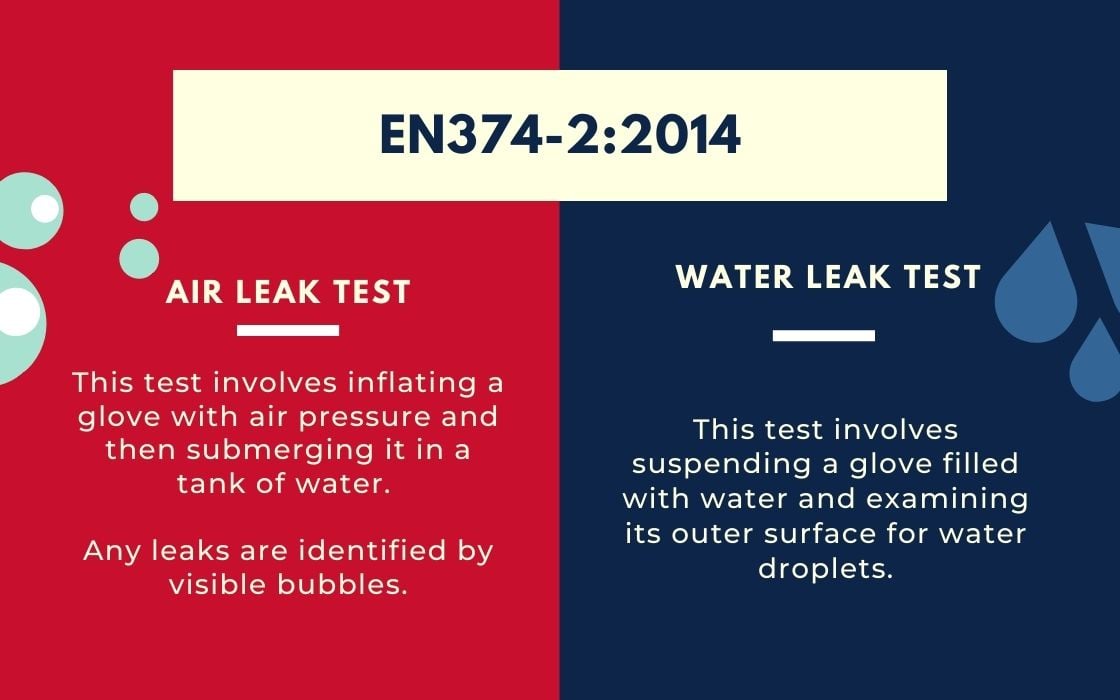
We have talked about these two tests in our previous article where we have come into an interesting discussion of how rubber gloves are tested and graded as waterproof, which is by carry out air leak test and water leak test.
So, how do we know if the gloves have pass the air leak and water leak test?
Take a look if the pictogram below exist on the gloves marking or at the gloves packaging.
For gloves that have passed the water leak and air leak test, it also means that microbes won’t be able to pass through the gloves. Hence it is being awarded the pictogram for microorganism hazards.
Please note that without the word “virus” beneath the pictogram, it means that the glove is not tested against virus.
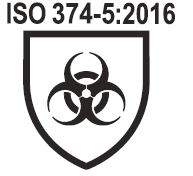
EN16523-1:2015 Permeation test
What is permeation?
Permeation is the process of which chemicals move through a glove at a molecular level.
The resistance of a protective glove material to permeation by a solid or liquid chemical is determined by measuring the normalized breakthrough time (NBT) of the chemical through the glove material.
In another words, through the permeation test results, we will get to know which glove is more chemical resistant than the other.
What is permeation test?
Testing is carried out in accordance with EN 16523-1:2015.
In the permeation test apparatus, the glove material separates the test chemical from the collecting medium.
The collecting medium, which can be a gas, a liquid or a solid, is analyzed quantitatively for its concentration of the chemical and thereby the amount of that chemical that has permeated the barrier as a function of time.
Test results are reported based upon the normalized breakthrough time (NBT) achieved.
There are six permeation performance levels: the highest level of protection being level 6, which shows a breakthrough time of greater than 480 minutes.
| Normalized Breakthrough Time (in minutes) | Performance Level |
| >10 | Level 1 |
| >30 | Level 2 |
| >60 | Level 3 |
| >120 | Level 4 |
| >240 | Level 5 |
| >480 | Level 6 |
The standard only requires a permeation level 2 to show the letter beneath the pictogram but there are 6 levels, so depending on the actual chemical used and the level of protection required, you may want to take this into consideration during the gloves selection process.
Before we move on to explain further about the classes of the chemicals for the chemical permeation test, let me show you the example of how the letters will be presented beneath the pictogram. Not sure how to interpret those letters? Read further and you will find the answer.
.png)
Chemical classes for the chemical permeation test
Under EN ISO 374-1:2016, gloves manufacturer can select 18 classes of chemicals for the chemical permeation test based on their product composition.
So which are those 18 classes of chemicals? Take a look at the table below. Each chemical comes with a code letter, CAS no. as well as the chemical class.
If you would like to understand what kind of chemical can the gloves resist, or if you would like to find out if the gloves are suitable for your application area, compare the letters at the pictogram with the table below:
| Code letters | Chemical | CAS No. | Class |
| A | Methanol | 67-56-1 | Primary alcohol |
| B | Acetone | 67-64-1 | Ketone |
| C | Acetonitrile | 75-05-8 | Nitrile compound |
| D | Dichloromethane | 75-09-2 | Chlorinated hydrocarbon |
| E | Carbon disulphide | 75-15-0 | Sulphur containing organic compound |
| F | Toluene | 108-88-3 | Aromatic hydrocarbon |
| G | Diethylamine | 109-89-7 | Amine |
| H | Tetrahydrofuran | 109-99-9 | Heterocyclic and ether compound |
| I | Ethyl acetate | 141-78-6 | Ester |
| J | n-Heptane | 142-82-5 | Saturated hydrocarbon |
| K | Sodium hydroxide 40% | 1310-73-2 | Inorganic base |
| L | Sulphuric acid 96% | 7664-93-9 | Inorganic mineral acid, oxidizing |
| M | Nitric acid 65% | 7697-37-2 | Inorganic mineral acid, oxidizing |
| N | Acetic acid 99% | 64-19-7 | Organic acid |
| O | Ammonium hydroxide 25% | 1336-21-6 | Organic base |
| P | Hydrogen peroxide 30% | 7722-84-1 | Peroxide |
| S | Hydrofluoric acid 40% | 7664-39-3 | Inorganic mineral acid |
| T | Formaldehyde 37% | 50-00-0 | Aldehyde |
What is Type A chemical resistant gloves?
And if you have noticed that there is a term above the pictogram written as “Type A”, it means that the glove is being certified as Type A chemical resistant gloves due to its ability to withstand a minimum breakthrough time of 30 minutes against minimum 6 test chemicals.
As a summary, the glove must withstand a minimum breakthrough time below to be certified as either Type A or Type B or Type C chemical resistant gloves.
| No. of test chemicals that pass minimum performance level | Minimum performance level of each test chemical | Certified as |
| 6 | Level 2 | Type A Chemical Resistant Gloves |
| 3 | Level 2 | Type B Chemical Resistant Gloves |
| 1 | Level 1 | Type C Chemical Resistant Gloves |
EN374-4 Degradation test
What is degradation?
When chemical protective gloves come into contact with chemicals for a period of time, acting like a sponge soaking up liquids and holding them against the skin, this can degrades the gloves.
When degradation occur, it also means that the barrier function of the gloves against chemicals and also the physical characteristics of the gloves started to change.
But how do we identify that the gloves have undergo degradation?
Well, there are some indications of degradation such as flaking, swelling, disintegration, embrittlement, colour change, dimensional change, appearance, hardening, softening, etc.
What is degradation test?
Degradation test is to determine the resistance of a protective glove material to degradation by a liquid chemical with continuous contact.
It is determined by measuring the puncture resistance change of the glove material before and after continuous contact with the challenge test chemical. The force required to push a stylus through the glove material is measured, both before and after the exposure of the gloves specimens to the challenge chemical.
Degradation shall be determined according to EN374-4:2013 for each chemical claimed on the product marking. There is no minimum requirement for degradation performance but the results of the tests in percentage (%) must be reported in the user information.
Below is an example of the user information for our Type A chemical resistance nitrile gloves. Degradation result for each challenge chemical is being reported in the user information.

Now you may ask, what sorts of information we can interpret from this user information?
Since we have covered about the permeation performance level and also the code of chemicals in the previous section where we explained about permeation test, we will now focus on the degradation results in percentage at this part.
The percentage means that the force for puncture dropped by x% as compared to the control test where the glove specimen is not exposed to any challenged chemical.
The smaller the degradation percentage, the higher the permeation performance level, meaning that the protective gloves have a better resistance to the degradation of the challenged chemical.
Conclusion
When looking for gloves, it is especially important to communicate your application needs with the glove manufacturer.
As different working environment and users will have different needs, it is advisable that the users or the responsible safety officers to define the individual requirements and ask the gloves manufacturer for the specific protective performance of the gloves.
Thank you for your time and reading this article until the end. We hope that this article can help you in understanding more about the gloves standard, and by using those information you will be able to make your decision effectively.
Get in touch with us if you’re interested in learning more about what we have to offer or would like some professional advice from one of our experts.
If you’re interested in reading more articles like this, subscribe to our blog and follow our Linkedin page for the latest updates.



